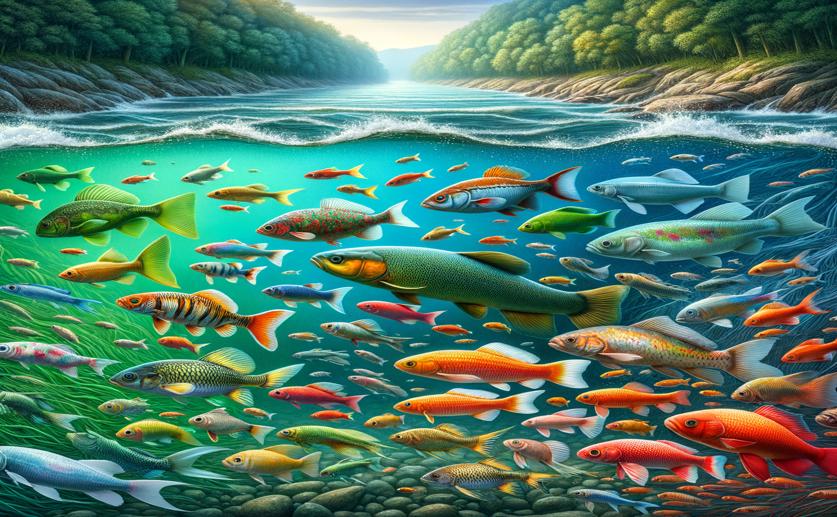Comparing Growth and Lifespan of Fish in Upper Yellow River

Image Source: Natural Science News, 2024
Key Findings
- In China's Yellow River, G. huanghensis fish are larger and live longer in the Gansu section than in Ningxia
- Ningxia's G. huanghensis show signs of overfishing, with higher mortality and exploitation rates
- Environmental changes and human activities may explain the differences between the two fish populations
Understanding the delicate balance of aquatic ecosystems is crucial, especially as environmental changes and human activities increasingly threaten their stability. The Gobio huanghensis, a small fish native to China's Yellow River, serves as a prime example of how these pressures can alter the ecological structure of a population. Researchers from the Chinese Academy of Fishery Sciences conducted a comparative study to assess the impact on G. huanghensis populations in two distinct sections of the upper Yellow River: the Gansu and Ningxia sections[1].
The study involved the collection of 1147 individual fish, with 427 from the Gansu section and 720 from the Ningxia section. They analyzed several ecological parameters, including age composition, growth characteristics, mortality rate, and exploitation rate, to determine the health and viability of the G. huanghensis populations.
In terms of physical growth, the Gansu section's G. huanghensis ranged from 5.00 to 22.80 cm in total length, with an average size of 12.68 cm. The Ningxia section's fish were generally smaller, with lengths between 2.15 and 20.65 cm and an average of 9.48 cm. Age composition revealed that in the Gansu section, female fish lived up to 7 years, while males lived up to 6 years. In contrast, both female and male fish in the Ningxia section only reached up to 5 years of age.
The study also examined the relationship between total length and body weight, finding that Gansu fish exhibited positive allometric growth, meaning their weight increased faster than their length. In the Ningxia fish, negative allometric growth was observed, where weight gain did not keep pace with length increase. These growth patterns were quantified using the von Bertalanffy growth equation, which showed that the Gansu fish had a slightly higher asymptotic total length (the theoretical maximum size a fish can reach) and a lower growth coefficient compared to the Ningxia fish.
Mortality rates, which combine natural and fishing-induced deaths, were higher in the Ningxia section. Similarly, the exploitation rate, which measures the proportion of the population harvested by fishing, indicated potential overexploitation in the Ningxia section.
These findings suggest that environmental changes and prolonged fishing pressures may be driving the differences observed between the two populations. The study provides empirical evidence supporting the importance of understanding life history strategies and their relationship with ecological parameters, as previously highlighted in studies that connected fish life history strategies to flow regimes in rivers[2] and the effects of population fragmentation on brook trout[3].
The Gansu section's G. huanghensis, with its larger size, longer lifespan, and lower mortality and exploitation rates, may be better adapted to its environment or subject to less intense fishing pressures. In contrast, the Ningxia section's population, characterized by smaller size, shorter lifespan, higher mortality, and higher exploitation rates, may be experiencing more significant environmental stress and overfishing.
This recent research underscores the need for targeted conservation strategies that consider both the natural flow regimes of rivers, which shape life histories and population structures, and the impact of human activities, such as habitat fragmentation and overfishing. By integrating these considerations, we can better manage and protect freshwater ecosystems and the species that depend on them. The study by the Chinese Academy of Fishery Sciences adds a valuable piece to the puzzle of how to sustainably manage fish populations in the face of changing environments and human pressures.
EcologyAnimal Science
References
Main Study
1) A comparative study on the age, growth, and mortality of Gobio huanghensis (Luo, Le & Chen, 1977) in the Gansu and Ningxia sections of the upper Yellow River, China.
Published 6th March, 2024
https://doi.org/10.1186/s12862-024-02217-2
Related Studies
2) Life history theory predicts fish assemblage response to hydrologic regimes.
Journal: Ecology, Issue: Vol 93, Issue 1, Jan 2012
Related Articles





 11th February, 2024 | Greg Howard
11th February, 2024 | Greg Howard